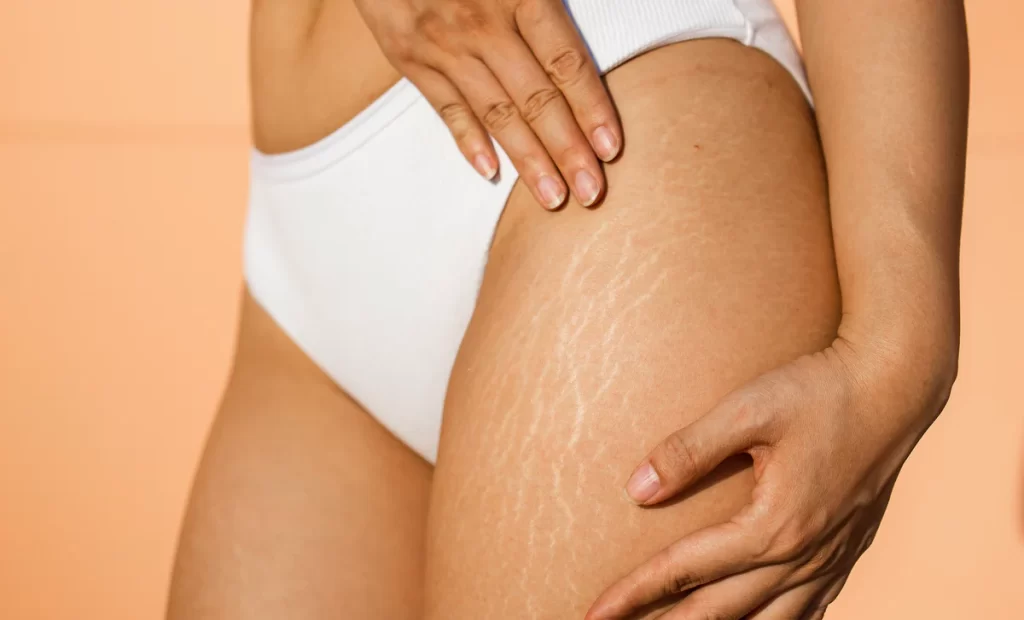Stretch Mark Removal: Exploring Options for Smoother Skin
Posted on: March 7, 2024
Stretch mark removal has become a sought-after solution for those aiming to restore skin’s appearance, enhancing confidence and comfort in one’s own body. With advancements in skincare technology, various effective methods have emerged, tailored to meet diverse needs and skin types. This post delves into the realm of stretch mark removal, offering insights on the most promising treatments available today. From topical solutions to cutting-edge laser therapy, we explore how these interventions work, their benefits, and what individuals can expect during their journey towards smoother, more resilient skin.
Understanding Stretch Marks Formation
Skin Elasticity
Collagen and elastin play crucial roles in maintaining skin elasticity. These proteins allow the skin to stretch and bounce back without damage. However, when the skin stretches rapidly, it can outpace collagen and elastin production. This imbalance leads to dermal tears.
Rapid weight gain, pregnancy, and growth spurts are common triggers. They force the skin to expand quickly. As a result, the underlying support structure of the skin breaks down.
Dermal Tears
When collagen and elastin cannot keep up with rapid stretching, dermal tears occur. These appear as streaks on the surface of the skin. Initially red or purple, they fade to white or silver over time.
These marks signify where the skin’s support structure has failed. Despite their name, stretch marks are not actual tears in the outer layer of skin but in the deeper layers.
Common Areas
Stretch marks often appear on areas subjected to rapid expansion.
- The abdomen sees significant stretching during pregnancy.
- Thighs and hips expand during growth spurts or weight gain.
- Breasts may also develop stretch marks due to changes in size from puberty, weight fluctuations, or pregnancy.
Each area reflects where skin expansion exceeds collagen and elastin production capacity. This results in visible markings that many seek to minimize or remove for cosmetic reasons.
Causes and Prevention of Stretch Marks
Key Factors
Pregnancy, weight gain, and puberty stand as primary causes for stretch marks. These life stages prompt rapid body changes.
Skin stretches quickly during these times. This fast expansion can lead to breaks in elastin fibers within the skin. Elastin is crucial for maintaining skin’s elasticity.
Genetic Influence
Genetics also play a significant role in one’s susceptibility to stretch marks. If your family members have them, you might too.
This predisposition is tied to variations in skin structure and function. It affects how well skin can stretch without leaving marks.
Diet Importance
Maintaining a healthy diet boosts skin elasticity. Foods rich in vitamins C, E, and zinc support the production of collagen and elastin.
A balanced diet nourishes the skin from the inside out. It helps prevent the tearing that leads to hyperpigmentation and marks.
Moisturizing Benefits
Regular moisturizing keeps skin supple and hydrated. This practice is essential for preventing stretch marks.
Hydrated skin can stretch more easily without damage. Use products that enhance moisture retention daily.
Overview of Stretch Mark Removal Methods
Topical Treatments
Topical treatments offer a non-invasive approach to reducing stretch marks. They work by moisturizing and healing the skin, making stretch marks less noticeable. Creams and oils rich in vitamins A and E are popular choices. Their effectiveness varies, often depending on how old the stretch marks are.
Laser Therapy
Laser therapy stands out as a more advanced method for stretch mark removal. It uses concentrated light to stimulate collagen and elastin production in the skin. This process helps in repairing and rejuvenating the affected areas. Different types of lasers target various aspects of stretch marks, including their color and texture.
The age and color of stretch marks significantly influence laser therapy’s success rate. Newer, red-colored marks tend to respond better than older, faded ones.
Microdermabrasion
Microdermabrasion is another technique that improves the appearance of stretch marks through exfoliation. It involves using fine crystals or a diamond-tipped wand to remove dead skin cells from the top layer of the skin. This promotes new skin growth that can make stretch marks look smoother and less visible.
Like other methods, microdermabrasion’s effectiveness can depend on the age and color of the stretch marks being treated.
Non-Surgical Options for Smoother Skin
Retinoid Creams
Retinoid creams stand out among non-surgical treatments. They encourage new collagen production. This helps in reducing the appearance of stretch marks. Dermatologists often recommend these creams for their effectiveness.
Applying these creams consistently can lead to noticeable improvements. However, they might not work for everyone. Skin type and the age of stretch marks play a role.
Chemical Peels
Chemical peels offer another avenue for smoother skin. They remove the outer layer, revealing fresher and less marked skin beneath.
This treatment requires a series of sessions with a dermatologist. Each session gradually improves skin texture by stimulating collagen renewal.
Microneedling
Microneedling is gaining popularity as a method to stimulate skin regeneration. Tiny needles create micro-injuries on the skin, prompting it to heal itself.
This process boosts collagen production, essential for healthy skin. It’s particularly effective for recent stretch marks but also works on older ones with more sessions.
Surgical Techniques for Lasting Results
Tummy Tuck
Abdominoplasty, commonly known as a tummy tuck, stands out as a surgical solution. This procedure specifically targets stretch marks below the belly button. By removing excess skin and fat, it also tightens the abdominal area. Patients see significant improvements after recovery.
The process requires one to a few treatment sessions, depending on individual needs. The effects are permanent, offering relief for years to come.

Thigh and Arm Lifts
Similar to abdominoplasty, thigh lifts and arm lifts provide solutions by tightening skin where stretch marks have formed. These procedures focus on areas affected by weight fluctuations or aging.
They involve removing excess skin to improve overall appearance. Like with tummy tucks, these options require multiple sessions for optimal results.
Permanent Solutions
Surgical options are indeed more invasive than non-surgical methods discussed earlier. However, they offer permanent removal of stretch marks in treated areas.
Patients should weigh the effectiveness against the time and commitment required for surgery and recovery.
Aftercare for Enhanced Skin Health
Post-Treatment Care
After undergoing surgical techniques for stretch mark removal, optimal healing is crucial. It ensures the longevity of results and minimizes potential side effects. Patients must adhere to post-treatment instructions provided by their healthcare professionals. This often includes keeping the treated area clean and applying prescribed topical treatments.
Proper aftercare accelerates the recovery process. It also prevents infection, a common concern after skin procedures. Following these guidelines closely enhances the overall improvement in skin health.
Sun Protection
One of the most critical aspects of aftercare involves protecting the skin from sun damage. The treated areas are particularly vulnerable to UV rays, which can lead to hyperpigmentation or even reverse some benefits gained from treatment.
Applying a high-SPF sunscreen daily is essential, regardless of weather conditions. This practice should become a regular part of one’s skincare routine to maintain results and support ongoing skin health.
Gentle Skincare
To further support healing and maintain treatment results, adopting a gentle skincare routine is advisable. Products containing aloe vera are recommended due to their soothing properties that promote recovery and hydration without irritating sensitive post-treatment skin.
Avoiding harsh chemicals or exfoliants during the initial weeks following treatment helps prevent unnecessary stress on healing tissues. Such measures contribute significantly to long-term skin improvement and health.
Tips to Prevent Future Stretch Marks
Stable Weight
Maintaining a stable weight is crucial. Rapid weight gain or loss stretches the skin, leading to marks. Aim for gradual changes.
Eating balanced meals helps. Focus on portions and nutritional value. This strategy prevents sudden skin stretching.
Regular Exercise
Exercise boosts skin elasticity and health. It keeps the skin firm, reducing mark risks.
Activities like yoga and swimming are effective. They improve circulation and skin flexibility. Incorporate them into your routine for best results.
Nutritious Diet
A diet rich in vitamins supports strong skin. Vitamins C, D, and E are especially important.
Foods like oranges, almonds, and salmon are great sources. They enhance skin strength and resilience against stretching.
Incorporating these foods into daily meals is beneficial. It provides the necessary nutrients for healthy skin maintenance.
Embracing Smooth Skin with Confidence
Self Acceptance
Embracing one’s skin, despite its imperfections, is a journey towards self-love. Stretch marks are a common concern among many people. They often appear due to rapid growth or weight changes. While they might affect the appearance and texture of the skin, they do not define one’s beauty or worth.
It’s crucial to remember that every person has scars or marks that tell their unique story. These stories include periods of growth, change, and resilience. By accepting these marks as part of oneself, individuals can foster a more positive relationship with their body.
Confidence Boost
Seeking treatment for stretch marks can significantly boost self-esteem for some clients. With various products and approaches available today, reducing the visibility of these scars is possible. Light therapy and specialized creams can improve skin texture and appearance over time.
Feeling confident in one’s skin contributes to overall well-being. It allows people to focus on what truly matters – their talents, dreams, and relationships rather than dwelling on physical imperfections.
Beauty Redefined
Perfection is an unrealistic standard that no one truly achieves. Recognizing this fact helps in redefining beauty standards to be more inclusive and realistic. Celebrating all aspects of oneself includes acknowledging areas affected by stretch marks with kindness rather than criticism.
This perspective shift encourages not only acceptance but also an appreciation for the body’s capability to grow and adapt through life’s challenges.
Final Remarks
The journey through understanding, preventing, and treating stretch marks reveals a multifaceted approach to skin health. Individuals have access to a spectrum of methods ranging from non-surgical interventions to surgical solutions, each tailored to different needs and outcomes. This exploration underscores the importance of informed decision-making based on one’s unique skin condition and personal health goals. Proper aftercare and preventive measures further enhance the effectiveness of these treatments, ensuring long-lasting results and improved skin confidence.
Embracing smooth skin requires commitment and an understanding that stretch marks are a common, treatable condition. It encourages those affected to seek out professional advice and consider the most suitable options available. For lasting skin health and confidence, individuals are urged to consult with dermatological experts. This proactive step can significantly impact one’s quality of life, fostering a positive self-image and well-being.
Frequently Asked Questions
What causes stretch marks to form?
Stretch marks, or striae, are caused by rapid stretching of the skin due to growth spurts, weight gain, pregnancy, or muscle growth. They initially appear as reddish or purple lines but gradually fade to a lighter shade.
Can stretch marks be completely removed?
While it’s challenging to completely remove stretch marks, various treatments can significantly reduce their appearance. Options include laser therapy, microdermabrasion, and topical creams. The effectiveness varies depending on the age and severity of the stretch marks.
Are there any non-surgical methods to reduce stretch marks?
Yes, there are several non-surgical options such as topical treatments like retinoid creams and hyaluronic acid, microdermabrasion, and laser therapy. These methods aim to stimulate collagen production and improve skin texture.
How do surgical techniques compare for removing stretch marks?
Surgical techniques like abdominoplasty (tummy tuck) may offer lasting results for removing stretch marks located on the abdomen by physically removing the excess skin. However, they come with longer recovery times and higher risks compared to non-surgical methods.
What aftercare is recommended following stretch mark treatment?
Post-treatment care typically involves keeping the treated area moisturized and protected from sun exposure. Following your healthcare provider’s specific instructions is crucial for healing and achieving optimal results.
How can future stretch marks be prevented?
Maintaining a healthy lifestyle with balanced nutrition and regular exercise helps manage body weight changes that can cause stretch marks. Using moisturizers can also keep the skin supple and less prone to tearing when stretched.
Is it possible to embrace smooth skin despite having had stretch marks?
Absolutely! Through a combination of treatments tailored to individual needs and preventive measures against new formations, one can significantly improve skin texture and health—embracing smoother skin with confidence over time.




